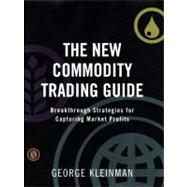
What is included with this book?
George Kleinman is President of the successful futures advisory, brokerage, and trading firm, Commodity Resource Corp (CRC). George founded CRC in 1983 from the floor of the Minneapolis Grain Exchange to offer a more personalized level of service to commodity traders.
He entered the business with Merrill Lynch Commodities (1978-1983). At Merrill he attained the honor of “Golden Circle”--one of Merrill’s top ten commodity brokers internationally. For more than 25 years, George was a member of various commodity exchanges. He is the author of three previous books on commodities and futures trading.
He has developed his own proprietary trading techniques and is Executive Editor of the commodity trading advisory service Futures Market Forecaster. In 1995, George relocated to northern Nevada and today trades from his office overlooking beautiful Lake Tahoe.
| Going the Way of the Dodo | p. 1 |
| It's Different This Time? | p. 2 |
| Eliminating People | p. 11 |
| Capturing a 5,000% Return | p. 21 |
| Two Chart Patterns That Work! | p. 29 |
| The Breakout from Consolidation | p. 31 |
| False Breakouts | p. 36 |
| Six Rules for Trading Breakouts from Consolidation | p. 37 |
| The Head and Shoulders (H&S) | p. 38 |
| Ten Rules for Successfully Trading the Head and Shoulders | p. 43 |
| The Voice from the Tomb (Super Seasonal #1) | p. 47 |
| The Soy Secret (Super Seasonal #2) | p. 53 |
| The Significant News Indicator | p. 59 |
| Six News Rules | p. 60 |
| SNI Rules | p. 63 |
| Breaking Par | p. 71 |
| A "Par" Case Study | p. 74 |
| The Trend Is Your Friend | p. 79 |
| The Natural Number Method: A Breakthrough Strategy for Capturing Market Profits | p. 85 |
| The Natural Number Method (N#M) | p. 93 |
| How to Generate a Trade Signal | p. 93 |
| The Buy Signal | p. 93 |
| The Sell Signal | p. 95 |
| The Corn Campaign | p. 99 |
| Diversification | p. 126 |
| The 50-Day EMA | p. 132 |
| The RSI | p. 132 |
| Open Interest (OI) | p. 134 |
| Summary | p. 139 |
| How the Entry and Exit Prices and Return-Per-Contract Results Are Determined | p. 144 |
| Additional Trading Points for N#M | p. 145 |
| Determining the Time Interval | p. 145 |
| Time Interval Guide | p. 145 |
| Natural Number Break Points | p. 148 |
| Improvements-Should Judgment Ever Be Used? | p. 150 |
| Entering or Exiting Early When Close to the Natural Number | p. 151 |
| Final Thoughts | p. 152 |
| Trading Chaos | p. 153 |
| Moving Average Primer, an Open Interest Primer, and the Advanced Open Interest Course | p. 157 |
| A Moving Average Primer | p. 157 |
| Bottom Pickers Versus Trend Followers | p. 158 |
| A Moving Picture | p. 159 |
| The Simple Moving Average | p. 161 |
| How Many Days Should You Use in Your MA? | p. 164 |
| Disadvantages of the SMA | p. 164 |
| Alternatives to the SMA | p. 165 |
| Exponential and Weighted Moving Averages (EMA and WMA) | p. 165 |
| Summary | p. 168 |
| Open Interest | p. 168 |
| The Open Interest Primer | p. 168 |
| The Advanced OI Course | p. 169 |
| Six Profit Rules for Analyzing OI | p. 170 |
| Index | p. 173 |
| Table of Contents provided by Ingram. All Rights Reserved. |
The New copy of this book will include any supplemental materials advertised. Please check the title of the book to determine if it should include any access cards, study guides, lab manuals, CDs, etc.
The Used, Rental and eBook copies of this book are not guaranteed to include any supplemental materials. Typically, only the book itself is included. This is true even if the title states it includes any access cards, study guides, lab manuals, CDs, etc.